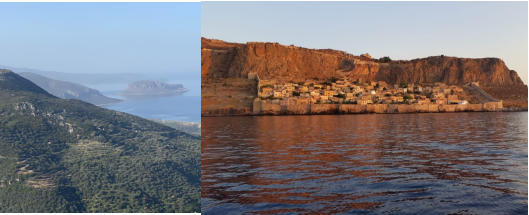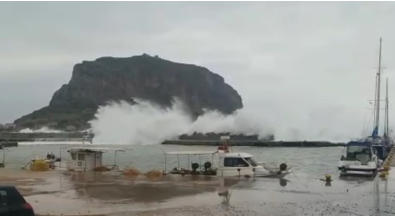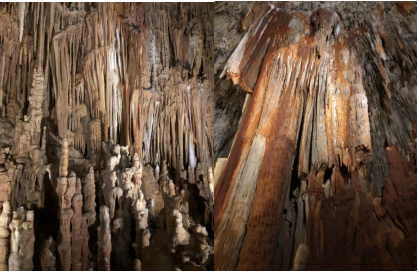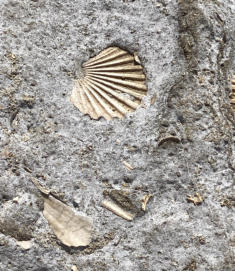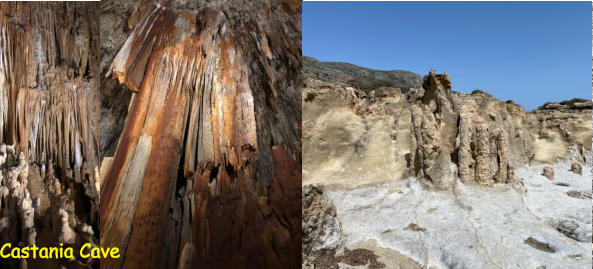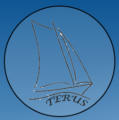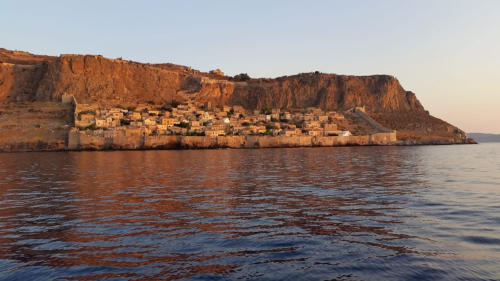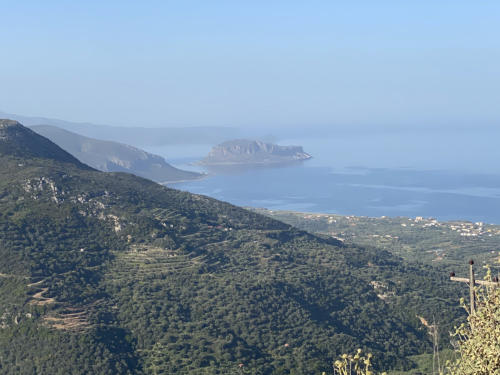
Start 2022: Where has all the water gone? (April - May 2022)
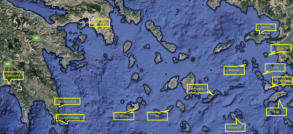

Our Journey: 2022


The 2022 season started on the 15 of March when we returned to the boat in Kalamata, south Peloponnese. Our plan was first to take Terus out of the water and do some maintenance work.
Peloponnese. Our plan was first to take Terus out of the water and do some maintenance work. According to our plan it would take one month On our list of things to do we had replacing two
According to our plan it would take one month On our list of things to do we had replacing two seacocks, applying a new layer of antifouling as well as some gelcoat repairs. All this work required
seacocks, applying a new layer of antifouling as well as some gelcoat repairs. All this work required Terus to be out of the water, but the water level was too low at that time of the year, April, so
Terus to be out of the water, but the water level was too low at that time of the year, April, so we could not do those jobs while Terus was in the water. Due to a combination of factors, the
we could not do those jobs while Terus was in the water. Due to a combination of factors, the water level was 50cm lower than normal. From the beginning of the year there was a long period of
water level was 50cm lower than normal. From the beginning of the year there was a long period of high atmospheric pressure, a lot of northerly winds and when we arrived the moon was full. We
high atmospheric pressure, a lot of northerly winds and when we arrived the moon was full. We needed at least 2m 30cm of water to take Terus out of the water, but there was only 1m 90cm
needed at least 2m 30cm of water to take Terus out of the water, but there was only 1m 90cm under the travel lift. We waited for 3 weeks but the water remained low. Luckily, while Terus was
under the travel lift. We waited for 3 weeks but the water remained low. Luckily, while Terus was in the water, after inspecting the antifouling and the propeller, we concluded that the boat was
in the water, after inspecting the antifouling and the propeller, we concluded that the boat was clean enough for the new season. Other boats that had been out of the water for the winter were
clean enough for the new season. Other boats that had been out of the water for the winter were less lucky and had to wait until the beginning of May to be put back in the water. On the 15 of
less lucky and had to wait until the beginning of May to be put back in the water. On the 15 of April at 3 am we left the marina and headed Eastwards to Elafonisos, an island close to Cap Malea
April at 3 am we left the marina and headed Eastwards to Elafonisos, an island close to Cap Malea at the end of the Peloponnese. As the conditions were excellent, we decided not to stop at
at the end of the Peloponnese. As the conditions were excellent, we decided not to stop at Elafonisos but to continue on to Monemvasia, 2 hours away. Soon after our arrival in Monemvasia, a
Elafonisos but to continue on to Monemvasia, 2 hours away. Soon after our arrival in Monemvasia, a couple of
couple of
 fisherman who we know very well advised us to go a few miles North to the port of Gerakas for a
fisherman who we know very well advised us to go a few miles North to the port of Gerakas for a couple of days. Given the weather forecast, they informed us that some rogue waves were on
couple of days. Given the weather forecast, they informed us that some rogue waves were on their way from Crete and would very likely go over the breakwaters. We followed their advice and
their way from Crete and would very likely go over the breakwaters. We followed their advice and returned three days later to Monemvasia. When we returned, several people in the harbor showed
returned three days later to Monemvasia. When we returned, several people in the harbor showed us how big the waves were that went over the breakwater. Beside it there was some camping that
us how big the waves were that went over the breakwater. Beside it there was some camping that was hit by the waves was written off by the insurance. As the northerly wind continued to blow,
was hit by the waves was written off by the insurance. As the northerly wind continued to blow, we decided to visit the area close to Cape Malea. The first place was the cave of Castania
we decided to visit the area close to Cape Malea. The first place was the cave of Castania 
 close to the city of Neapolis. This cave was recently discovered by a shepherd who noticed a
close to the city of Neapolis. This cave was recently discovered by a shepherd who noticed a crevasse in which there was a bee-hive. Upon looking more closely, he discovered a huge cave full
crevasse in which there was a bee-hive. Upon looking more closely, he discovered a huge cave full of stalagmites and stalactites. The guide to the cave showed us a place were there is some ash
of stalagmites and stalactites. The guide to the cave showed us a place were there is some ash from a fire, but it has not yet been dated. Whether the cave was occupied early on during the
from a fire, but it has not yet been dated. Whether the cave was occupied early on during the Neolithic Age, like many other caves in the Peloponnese, is unknot yet known.After the cave, we
Neolithic Age, like many other caves in the Peloponnese, is unknot yet known.After the cave, we moved closer to Cape Malea. In various places you can see numerous fossil ferns, as well as sea
moved closer to Cape Malea. In various places you can see numerous fossil ferns, as well as sea stars and shells. For us who normally fear the Cape it was a revelation that the place is worth to
stars and shells. For us who normally fear the Cape it was a revelation that the place is worth to visit.
visit.
 Peloponnese. Our plan was first to take Terus out of the water and do some maintenance work.
Peloponnese. Our plan was first to take Terus out of the water and do some maintenance work. According to our plan it would take one month On our list of things to do we had replacing two
According to our plan it would take one month On our list of things to do we had replacing two seacocks, applying a new layer of antifouling as well as some gelcoat repairs. All this work required
seacocks, applying a new layer of antifouling as well as some gelcoat repairs. All this work required Terus to be out of the water, but the water level was too low at that time of the year, April, so
Terus to be out of the water, but the water level was too low at that time of the year, April, so we could not do those jobs while Terus was in the water. Due to a combination of factors, the
we could not do those jobs while Terus was in the water. Due to a combination of factors, the water level was 50cm lower than normal. From the beginning of the year there was a long period of
water level was 50cm lower than normal. From the beginning of the year there was a long period of high atmospheric pressure, a lot of northerly winds and when we arrived the moon was full. We
high atmospheric pressure, a lot of northerly winds and when we arrived the moon was full. We needed at least 2m 30cm of water to take Terus out of the water, but there was only 1m 90cm
needed at least 2m 30cm of water to take Terus out of the water, but there was only 1m 90cm under the travel lift. We waited for 3 weeks but the water remained low. Luckily, while Terus was
under the travel lift. We waited for 3 weeks but the water remained low. Luckily, while Terus was in the water, after inspecting the antifouling and the propeller, we concluded that the boat was
in the water, after inspecting the antifouling and the propeller, we concluded that the boat was clean enough for the new season. Other boats that had been out of the water for the winter were
clean enough for the new season. Other boats that had been out of the water for the winter were less lucky and had to wait until the beginning of May to be put back in the water. On the 15 of
less lucky and had to wait until the beginning of May to be put back in the water. On the 15 of April at 3 am we left the marina and headed Eastwards to Elafonisos, an island close to Cap Malea
April at 3 am we left the marina and headed Eastwards to Elafonisos, an island close to Cap Malea at the end of the Peloponnese. As the conditions were excellent, we decided not to stop at
at the end of the Peloponnese. As the conditions were excellent, we decided not to stop at Elafonisos but to continue on to Monemvasia, 2 hours away. Soon after our arrival in Monemvasia, a
Elafonisos but to continue on to Monemvasia, 2 hours away. Soon after our arrival in Monemvasia, a couple of
couple of
 fisherman who we know very well advised us to go a few miles North to the port of Gerakas for a
fisherman who we know very well advised us to go a few miles North to the port of Gerakas for a couple of days. Given the weather forecast, they informed us that some rogue waves were on
couple of days. Given the weather forecast, they informed us that some rogue waves were on their way from Crete and would very likely go over the breakwaters. We followed their advice and
their way from Crete and would very likely go over the breakwaters. We followed their advice and returned three days later to Monemvasia. When we returned, several people in the harbor showed
returned three days later to Monemvasia. When we returned, several people in the harbor showed us how big the waves were that went over the breakwater. Beside it there was some camping that
us how big the waves were that went over the breakwater. Beside it there was some camping that was hit by the waves was written off by the insurance. As the northerly wind continued to blow,
was hit by the waves was written off by the insurance. As the northerly wind continued to blow, we decided to visit the area close to Cape Malea. The first place was the cave of Castania
we decided to visit the area close to Cape Malea. The first place was the cave of Castania 
 close to the city of Neapolis. This cave was recently discovered by a shepherd who noticed a
close to the city of Neapolis. This cave was recently discovered by a shepherd who noticed a crevasse in which there was a bee-hive. Upon looking more closely, he discovered a huge cave full
crevasse in which there was a bee-hive. Upon looking more closely, he discovered a huge cave full of stalagmites and stalactites. The guide to the cave showed us a place were there is some ash
of stalagmites and stalactites. The guide to the cave showed us a place were there is some ash from a fire, but it has not yet been dated. Whether the cave was occupied early on during the
from a fire, but it has not yet been dated. Whether the cave was occupied early on during the Neolithic Age, like many other caves in the Peloponnese, is unknot yet known.After the cave, we
Neolithic Age, like many other caves in the Peloponnese, is unknot yet known.After the cave, we moved closer to Cape Malea. In various places you can see numerous fossil ferns, as well as sea
moved closer to Cape Malea. In various places you can see numerous fossil ferns, as well as sea stars and shells. For us who normally fear the Cape it was a revelation that the place is worth to
stars and shells. For us who normally fear the Cape it was a revelation that the place is worth to visit.
visit.
